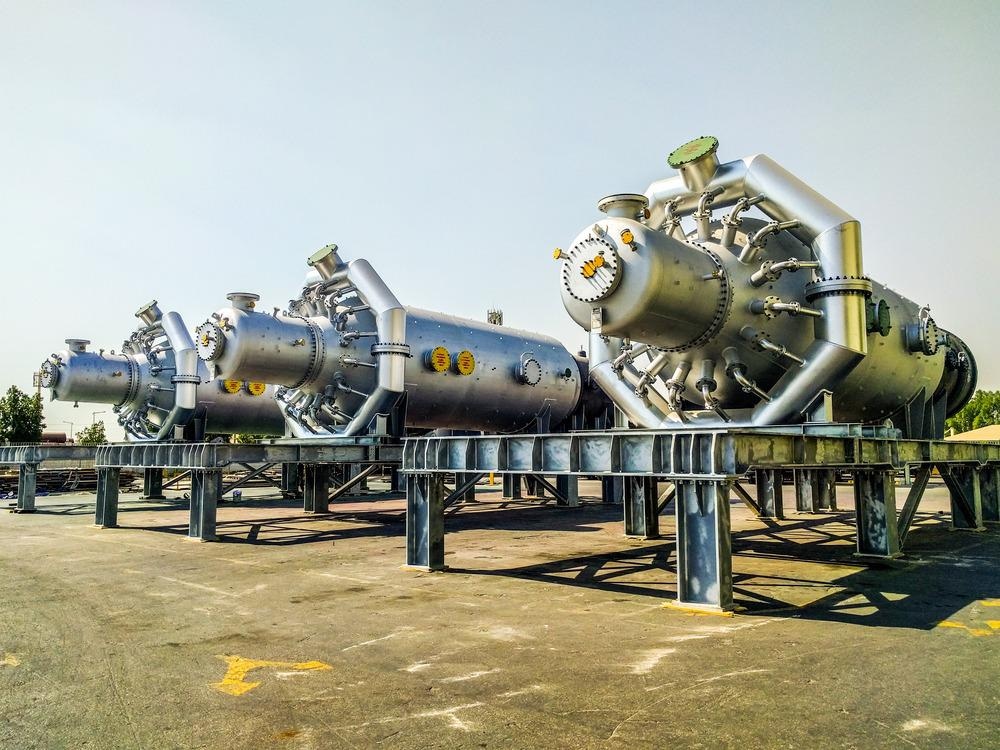Article updated on 26 August 2021

Image Credit: Muhammed Ibrahim/Shutterstock.com
All over the world, pressure vessels are being pressed into service beyond their design lifetimes. Advances in machine learning can lead to the deployment of increasingly reliable non-destructive testing (NDT) to inspect pressure vessels. The NOMAD study, a four-year research project to investigate NDT of reactor pressure vessels, is nearing its conclusion this month.
Pressure vessels are any structures that contain fluids at pressures different from the ambient and can include soda bottles, car tires, and airplane cabins. The American Society of Mechanical Engineers (ASME) defines pressure vessels as having a pressure higher than 15 psi and possessing certain dimensional requirements.
Section VIII of the ASME Boiler and Pressure Vessel Code (BPVC) and the Pressure Equipment Directive (PED) are the codes regulating the design, fabrication, testing, and maintenance of pressure vessels in the United States and the European Union, respectively.
Pressure vessels are critical equipment in several industries such as oil, gas, chemical, and nuclear plants where their rupture can lead to catastrophic failure of the entire facility. In nuclear power plants, failure of a reactive pressure vessel (RPV) can lead to the release of toxic pollutants into the environment.
For example, during the accident at Japan’s Fukushima Daiichi Nuclear Power Station in 2011, disruption of the cooling system led to overheating of the RPVs that subsequently melted the radioactive fuel contained in them. The radioactive fuel is presumed to have leaked through the steel RPV walls and contaminated the surroundings.
The NOMAD Project to Investigate Non-Destructive Testing of Reactor Pressure Vessels
In nuclear power plants, RPVs house the nuclear fuel core and cannot be replaced after the initial installation. They are subject to constant bombardment by nuclear radiation that leads to vessel wall embrittlement over time. As the operational lifetimes of several nuclear power plants are being extended for up to 80 years beyond their design lifetimes, more systematic NDT is required to ensure RPV integrity.
To address this issue, the European Commission is funding a four-year research project titled “Nondestructive Evaluation System for the Inspection of Operation-Induced Material Degradation in Nuclear Power Plants (NOMAD)” through the HORIZON 2020 program.
NOMAD brings together nine academic and industrial stakeholders in the field of nuclear power and NDT with the vision of developing a standardized NDT tool to assess material degradation, particularly embrittlement of materials due to radiation. The goal is to use this tool “in periodic safety reviews of the reactor pressure vessel complementary to the standardized destructive methods”.
Common NDT Techniques
The following is a summary of the NDT techniques being investigated by NOMAD:
- Micromagnetic methods for ferromagnetic materials such as steels:
- Micromagnetic Multiparameter Microstructure and Stress Analysis (3MA)
- Magnetic adaptive testing (MAT)
- Micromagnetic Inductive Response & Barkhausen Emission (MIRBE)
Micromagnetic methods are simple, cheap, and can be applied remotely.
- Electrical methods
- The Direct Current-Reversal Potential Drop (DCRPD)
- Thermoelectric power measuring method (TEPMM)
- Ultrasonic methods
This is the most widely used NDT technique.
Machine Learning Techniques to Improve NDT
NDT techniques are being further improved by the incorporation of machine learning techniques to inspect areas inaccessible to or tedious for human operators. Several methods are being developed to inspect austenitic steel welds, commonly used in pressure vessels due to their strength and corrosion resistance.
Prof. Yarens Cruz Hernández and colleagues from the Universidad de Matanzas, Cuba, along with colleagues from Hitachi Europe Ltd, Germany and the Center for Automation and Robotics, Spain recently developed a computer vision system to detect nonconformities in welds with a quality index of 99.5% in an industrial environment.
Evaluation of NDT data from inhomogeneous and/or anisotropic materials is another ongoing challenge. Dr. Katherine Tant and colleagues from the University of Strathclyde, UK, along with collaborators from the University of Edinburgh, UK, recently devised a new algorithm to extract crystal orientation distributions of polycrystalline austenitic steel welds from ultrasonic NDT data.
Future of NDT to Inspect Pressure Vessels
Since NDT is an indirect measurement of material properties, the primary prerequisite of using NDT methods to assess material damage is to calibrate/correlate the results of NDT to destructive testing methods which are a more accurate measurement of material characteristics (although destructive testing does not take into account material inhomogeneities).
Advances in machine learning techniques to extract more information from NDT measurement data as well as improved databases of material properties and NDT measurements from projects such as NOMAD will lead to the development of more reliable NDT techniques to inspect pressure vessels.
The full results and recommendations of the NOMAD project will be available after the project concludes on 31 May 2021.
References and Further Reading
American Society for Mechanical Engineers (2021). Boiler and Pressure Vessel Code(BPVC). [Online] Available at: https://www.asme.org/codes-standards/find-codes-standards/bpvc-complete-code-boiler-pressure-vessel-code-complete-set (Accessed on 16 May 2021).
European Union (2014). Pressure Equipment Directive (PED). [Online] Available at: https://ec.europa.eu/growth/sectors/pressure-gas/pressure-equipment/directive_en (Accessed on 16 May 2021).
Nondestructive Evaluation System for the Inspection of Operation-Induced Material Degradation in Nuclear Power Plants [Online]. Available at: https://nomad-horizon2020.eu (Accessed on 16 May 2021).
Cruz, Y.J., Rivas, M., Quiza, R., Beruvides, G. and Haber, R.E. (2020) Computer Vision System for Welding Inspection of Liquefied Petroleum Gas Pressure Vessels Based on Combined Digital Image Processing and Deep Learning Techniques. Sensors, 20, pp. 4505. Available at: https://doi.org/10.3390/s20164505.
Tant, K. M. M., Galetti, E. , Mulholland, A. J. , Curtis, A. and Gachagan, A. (2020) Effective grain orientation mapping of complex and locally anisotropic media for improved imaging in ultrasonic non-destructive testing, Inverse Problems in Science and Engineering, 28:12, pp.1694-1718, Available at https://doi.org/10.1080/17415977.2020.1762596.
Disclaimer: The views expressed here are those of the author expressed in their private capacity and do not necessarily represent the views of AZoM.com Limited T/A AZoNetwork the owner and operator of this website. This disclaimer forms part of the Terms and conditions of use of this website.